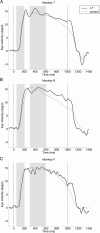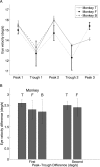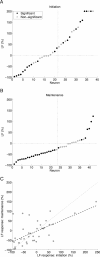FEFsem neuronal response during combined volitional and reflexive pursuit
- PMID: 28538993
- PMCID: PMC5445972
- DOI: 10.1167/17.5.13
FEFsem neuronal response during combined volitional and reflexive pursuit
Abstract
Although much is known about volitional and reflexive smooth eye movements individually, much less is known about how they are coordinated. It is hypothesized that separate cortico-ponto-cerebellar loops subserve these different types of smooth eye movements. Specifically, the MT-MST-DLPN pathway is thought to be critical for ocular following eye movements, whereas the FEF-NRTP pathway is understood to be vital for volitional smooth pursuit. However, the role that these loops play in combined volitional and reflexive behavior is unknown. We used a large, textured background moving in conjunction with a small target spot to investigate the eye movements evoked by a combined volitional and reflexive pursuit task. We also assessed the activity of neurons in the smooth eye movement subregion of the frontal eye field (FEFsem). We hypothesized that the pursuit system would show less contribution from the volitional pathway in this task, owing to the increased involvement of the reflexive pathway. In accordance with this hypothesis, a majority of FEFsem neurons (63%) were less active during pursuit maintenance in a combined volitional and reflexive pursuit task than during purely volitional pursuit. Interestingly and surprisingly, the neuronal response to the addition of the large-field motion was highly correlated with the neuronal response to a target blink. This suggests that FEFsem neuronal responses to these different perturbations-whether the addition or subtraction of retinal input-may be related. We conjecture that these findings are due to changing weights of both the volitional and reflexive pathways, as well as retinal and extraretinal signals.
Figures







Similar articles
-
Temporal dynamics of retinal and extraretinal signals in the FEFsem during smooth pursuit eye movements.J Neurophysiol. 2017 May 1;117(5):1987-2003. doi: 10.1152/jn.00786.2016. Epub 2017 Feb 15. J Neurophysiol. 2017. PMID: 28202571 Free PMC article.
-
Modeling of smooth pursuit-related neuronal responses in the DLPN and NRTP of the rhesus macaque.J Neurophysiol. 2005 Jan;93(1):108-16. doi: 10.1152/jn.00588.2004. Epub 2004 Aug 18. J Neurophysiol. 2005. PMID: 15317840
-
Extraretinal signals in MSTd neurons related to volitional smooth pursuit.J Neurophysiol. 2006 Nov;96(5):2819-25. doi: 10.1152/jn.00538.2006. Epub 2006 Jun 21. J Neurophysiol. 2006. PMID: 16790593
-
The neuronal basis of on-line visual control in smooth pursuit eye movements.Vision Res. 2015 May;110(Pt B):257-64. doi: 10.1016/j.visres.2014.06.008. Epub 2014 Jul 1. Vision Res. 2015. PMID: 24995378 Free PMC article. Review.
-
The neural basis of smooth pursuit eye movements in the rhesus monkey brain.Brain Cogn. 2008 Dec;68(3):229-40. doi: 10.1016/j.bandc.2008.08.014. Epub 2008 Oct 2. Brain Cogn. 2008. PMID: 18835077 Review.
Cited by
-
Diagnosis of Parkinson's disease by eliciting trait-specific eye movements in multi-visual tasks.J Transl Med. 2025 Jan 14;23(1):65. doi: 10.1186/s12967-024-06044-3. J Transl Med. 2025. PMID: 39810187 Free PMC article.
-
Perceptual restoration fails to recover unconscious processing for smooth eye movements after occipital stroke.Elife. 2022 Jun 22;11:e67573. doi: 10.7554/eLife.67573. Elife. 2022. PMID: 35730931 Free PMC article.
References
-
- Asanuma, C., Thach, W. T., & Jones, E. G.. (1983a). Anatomical evidence for segregated focal groupings of efferent cells and their terminal ramifications in the cerebellothalamic pathway of the monkey. Brain Research Reviews, 5, 267–297. - PubMed
-
- Asanuma, C., Thach, W. T., & Jones, E. G.. (1983b). Distribution of cerebellar terminations in the ventral lateral thalamic region of the monkey. Brain Research Reviews, 5, 237–265. - PubMed
-
- Bogadhi, A. R., Montagnini, A., & Masson G.. (2013). Dynamic interaction between retinal and extraretinal signals in motion integration for smooth pursuit. Journal of Vision, 13 13: 5, 1–26, doi:10.1167/13.13.5. [PubMed] [Article] - DOI - PubMed
-
- Boussaoud, D., Desimone, R., & Ungerleider, L.G.. (1992). Subcortical connections of visual areas MST and FST in macaques. Visual Neuroscience, 9, 291–302. - PubMed
MeSH terms
Grants and funding
LinkOut - more resources
Full Text Sources
Other Literature Sources

